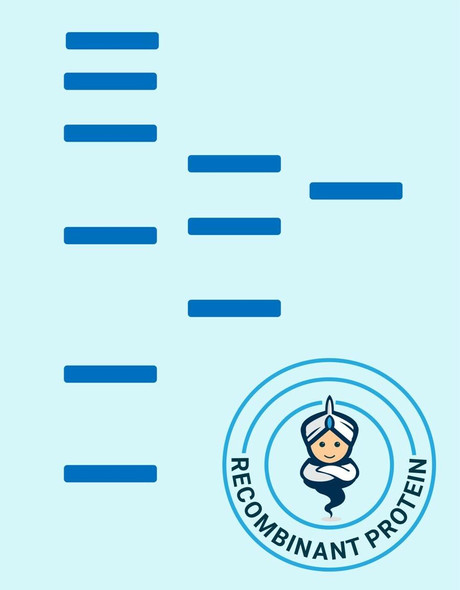Description
| Product Name: | Human RGS17 Recombinant Protein |
| Product Code: | RPPB4451 |
| Size: | 25µg |
| Species: | Human |
| Target: | RGS17 |
| Synonyms: | Regulator of G-protein signaling 17, RGS-17, RGSZ2, hRGS17. |
| Source: | Escherichia Coli |
| Physical Appearance: | Sterile Filtered colorless solution. |
| Formulation: | The RGS17 solution (1mg/ml) contains 20mM Tris-HCl buffer (pH 8.0), 0.1M NaCl,1mM DTT and 10% glycerol. |
| Stability: | Store at 4°C if entire vial will be used within 2-4 weeks. Store, frozen at -20°C for longer periods of time. For long term storage it is recommended to add a carrier protein (0.1% HSA or BSA).Avoid multiple freeze-thaw cycles. |
| Purity: | Greater than 90% as determined by SDS-PAGE. |
| Amino Acid Sequence: | MGSSHHHHHH SSGLVPRGSH MRKRQQSQNE GTPAVSQAPG NQRPNNTCCF CWCCCCSCSC LTVRNEERGE NAGRPTHTTK MESIQVLEEC QNPTAEEVLS WSQNFDKMMK APAGRNLFRE FLRTEYSEEN LLFWLACEDL KKEQNKKVIE EKARMIYEDY ISILSPKEVS LDSRVREVIN RNLLDPNPHM YEDAQLQIYT LMHRDSFPRF LNSQIYKSFV ESTAGSSSES |
RGS17 weakens the signaling activity of G-proteins by binding to activated GTP-bound G alpha subunits and performing as a GTPase activating protein (GAP), increasing the rate of conversion of the GTP to GDP. This hydrolysis allows the G alpha subunits to bind G beta/gamma subunit heterodimers, creating inactive G-protein heterotrimers, which terminates the signal. RGS17 has a vital part in ending the signaling by mu opioid receptors and development of tolerance to opioid analgesic drugs.
RGS17 Human Recombinant produced in E.coli is a single, non-glycosylated polypeptide chain containing 230 amino acids (1-210) and having a molecular mass of 26.5 kDa.The RGS17 is fused to a 20 amino acid His-Tag at N-terminus and purified by proprietary chromatographic techniques.
| UniProt Protein Function: | RGS17: Inhibits signal transduction by increasing the GTPase activity of G protein alpha subunits thereby driving them into their inactive GDP-bound form. Binds selectively to G(z)-alpha and G(alpha)-i2 subunits, accelerates their GTPase activity and regulates their signaling activities. The G(z)-alpha activity is inhibited by the phosphorylation and palmitoylation of the G- protein. Negatively regulates mu-opioid receptor-mediated activation of the G-proteins. |
| UniProt Protein Details: | Protein type:GAPs; GAPs, RGS Chromosomal Location of Human Ortholog: 6q25.3 Cellular Component: cytoplasm; plasma membrane; nucleus Molecular Function:GTPase activator activity Biological Process: positive regulation of GTPase activity |
| NCBI Summary: | This gene encodes a member of the regulator of G-protein signaling family. This protein contains a conserved, 120 amino acid motif called the RGS domain and a cysteine-rich region. The protein attenuates the signaling activity of G-proteins by binding to activated, GTP-bound G alpha subunits and acting as a GTPase activating protein (GAP), increasing the rate of conversion of the GTP to GDP. This hydrolysis allows the G alpha subunits to bind G beta/gamma subunit heterodimers, forming inactive G-protein heterotrimers, thereby terminating the signal. [provided by RefSeq, Jul 2008] |
| UniProt Code: | Q9UGC6 |
| NCBI GenInfo Identifier: | 21361405 |
| NCBI Gene ID: | 26575 |
| NCBI Accession: | NP_036551 |
| UniProt Secondary Accession: | Q9UGC6,Q5TF49, Q8TD61, Q9UJS8, |
| UniProt Related Accession: | Q9UGC6 |
| Molecular Weight: | 24,359 Da |
| NCBI Full Name: | regulator of G-protein signaling 17 |
| NCBI Synonym Full Names: | regulator of G-protein signaling 17 |
| NCBI Official Symbol: | RGS17�� |
| NCBI Official Synonym Symbols: | RGSZ2; RGS-17; hRGS17�� |
| NCBI Protein Information: | regulator of G-protein signaling 17 |
| UniProt Protein Name: | Regulator of G-protein signaling 17 |
| Protein Family: | Regulator of G-protein signaling |
| UniProt Gene Name: | RGS17�� |
| UniProt Entry Name: | RGS17_HUMAN |






